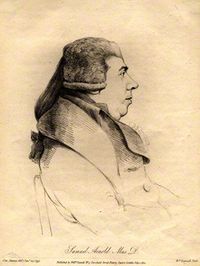Annotation:Oh Say Bonny Lass: Difference between revisions
No edit summary |
m (Text replacement - "garamond, serif" to "sans-serif") |
||
| Line 1: | Line 1: | ||
=='''Back to [[{{BASEPAGENAME}}]]'''== | =='''Back to [[{{BASEPAGENAME}}]]'''== | ||
---- | ---- | ||
<p><font face=" | <p><font face="sans-serif" size="4"> | ||
'''OH SAY BONNY LASS.''' AKA - "O bonny lass can you lie in a barrack," "Oh say simple maid have you form'd any notion." English; Air, Waltz (3/4 time). England, Northumberland. G Major. Standard tuning (fiddle). AB. The melody was the vehicle for a song [Roud No: V16444] in the three-act opera '''Inkle & Yarico''' [http://en.wikipedia.org/wiki/Inkle_and_Yarico] [https://archive.org/details/inkleyaricoopera00arno] (1787), music composed by Samuel Arnold (1740-1802) and a libretto by George Colman the Younger. It was based on a century-old tale widely known in Europe and America, and takes place in Barbados. | '''OH SAY BONNY LASS.''' AKA - "O bonny lass can you lie in a barrack," "Oh say simple maid have you form'd any notion." English; Air, Waltz (3/4 time). England, Northumberland. G Major. Standard tuning (fiddle). AB. The melody was the vehicle for a song [Roud No: V16444] in the three-act opera '''Inkle & Yarico''' [http://en.wikipedia.org/wiki/Inkle_and_Yarico] [https://archive.org/details/inkleyaricoopera00arno] (1787), music composed by Samuel Arnold (1740-1802) and a libretto by George Colman the Younger. It was based on a century-old tale widely known in Europe and America, and takes place in Barbados. | ||
[[File:arnold.jpg|200px|thumb|left|Samuel Arnold]] | [[File:arnold.jpg|200px|thumb|left|Samuel Arnold]] | ||
| Line 19: | Line 19: | ||
The melody appears under the title "O bonny lass can you lie in a barrack?" in the large 1840 music manuscript collection of multi-instrumentalist John Rook, of Waverton, Cumbria. | The melody appears under the title "O bonny lass can you lie in a barrack?" in the large 1840 music manuscript collection of multi-instrumentalist John Rook, of Waverton, Cumbria. | ||
</font></p> | </font></p> | ||
<p><font face=" | <p><font face="sans-serif" size="4"> | ||
''Source for notated version'': | ''Source for notated version'': | ||
<br> | <br> | ||
<br> | <br> | ||
</font></p> | </font></p> | ||
<p><font face=" | <p><font face="sans-serif" size="4"> | ||
''Printed sources'': Peacock ('''Peacock's Tunes'''), c. 1805; No. 17, p. 6. Raven ('''English Country Dance Tunes'''), 1984; p. 135. | ''Printed sources'': Peacock ('''Peacock's Tunes'''), c. 1805; No. 17, p. 6. Raven ('''English Country Dance Tunes'''), 1984; p. 135. | ||
<br> | <br> | ||
<br> | <br> | ||
</font></p> | </font></p> | ||
<p><font face=" | <p><font face="sans-serif" size="4"> | ||
''Recorded sources'': <font color=teal></font> | ''Recorded sources'': <font color=teal></font> | ||
</font></p> | </font></p> | ||
Revision as of 14:30, 6 May 2019
Back to Oh Say Bonny Lass
OH SAY BONNY LASS. AKA - "O bonny lass can you lie in a barrack," "Oh say simple maid have you form'd any notion." English; Air, Waltz (3/4 time). England, Northumberland. G Major. Standard tuning (fiddle). AB. The melody was the vehicle for a song [Roud No: V16444] in the three-act opera Inkle & Yarico [1] [2] (1787), music composed by Samuel Arnold (1740-1802) and a libretto by George Colman the Younger. It was based on a century-old tale widely known in Europe and America, and takes place in Barbados.

Inkle:
Oh, say, simple maid, have you form'd any notion,
Of all the rude dangers in crossing the ocean.
When winds whistle shrilly, ah! would they remind you,
To sigh with regret for the grot left behind you.
Yarico:
Ah, no, I could follow and sail the world over,
Nor think of my grot when I look at my lover,
The winds which blow round us, your arms for my pillow,
Will lull us to sleep while we're rock'd by the billow.
The melody appears under the title "O bonny lass can you lie in a barrack?" in the large 1840 music manuscript collection of multi-instrumentalist John Rook, of Waverton, Cumbria.
Source for notated version:
Printed sources: Peacock (Peacock's Tunes), c. 1805; No. 17, p. 6. Raven (English Country Dance Tunes), 1984; p. 135.
Recorded sources:
